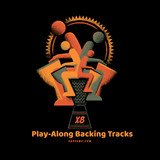History of Djembe Drums
The African djembe (also jembe, jenbe, yembe, sanbanyi in Susu; pronounced "ZHEM-bay") is a goatskin covered drum shaped like a large goblet and meant to be played with bare hands. Traditionally crafted djembe drums are carved in one single piece from hollowed out hardwood trees. Specific types of wood depend upon the forests accessible to the drum makers. Some West African hardwoods used for musician quality instruments (carved in Guinea, Senegal, Mali, and Ivory Coast) include dimba (bush mango), lenge, bois rouge, acajou, iroko, hare or khadi, and dugura.
As a result of the large goblet shape and the goatskin head, there is a significant difference in the tones produced. Striking the skin near the center produces a bass note; striking the skin near the rim can produce either a tone or slap note, depending on the technique used. The slap has a higher pitch than the tone. Some consider the djembe female and the Ashikos to be male. The djembe is said to contain 3 spirits. The spirit of the tree, the spirit of the animal of which the drumhead is made and the spirit of the instrument maker. The African djembe is also known as the magical drum.
The African djembe is used for ceremonial purposes such as a wedding, full moon or the start of a harvest season for farmers. There is general agreement that the origin of the African djembe is associated with a class of Mandinka/Susu blacksmiths known as Numu. The wide dispersion of the djembe drums throughout West Africa may be due to Numu migrations dating from the first millennium A.D.
The Malinke, an indigenous people who are spread throughout West Africa, use the djembe to help spread their message of peace. In the Malinke culture it's an expression of joy. And is often used as a way for the African people to share their thoughts about the world. African drummer Mamady Keita, named best djembe drummer in Africa by the Pan-African Festival in Algers puts it best: "For us personally it's a way for us to share our own thoughts about the world. It helps us show through music that all our problems are not needed, and that we can come together as people because we can come together to play music."
Djembe Buying Guide
2. Djembe Wood Source & Lathing [Video]
3. Djembe Shell Carving & Painting [Video]
5. Which Size Djembe is Right for Me? [Video]
6. Key Tuned vs. Rope Tuned Djembe
7. Djembe Drum: Wood vs. Synthetic
8. How to Tune a Djembe [Video]
10. A Note About African Djembes
11. Djembe Rhythm Exercises [Video]
12. Djembe Rope. Why Quality Matters.
13. Taking Care of your Djembe
14. History of Djembe Drums
15. How to Play the Djembe [Video]
16. Play the Djembe is Easy for All!
Recent Posts
-
X8 Drums Play-Along Backing Tracks
The new X8 Play-Along Series is being produced for our musician friends wanting a fresh way to work …9th Feb 2025 -
What is the Best Size Djembe for Beginners?
If you're new to the world of percussion and interested in learning the djembe, you're in for a t …16th Jul 2024 -
The Benefits of Becoming a Drumming Teacher: Transforming Passion into Profession
Why become a drumming teacher? Becoming a drumming teacher is an excellent way to share your pas …22nd May 2024



